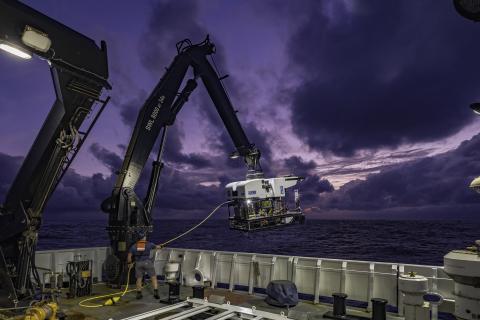The Open Ocean Trustees and partners are continuing progress on the mesophotic and deep benthic communities restoration projects selected in the 2019 Open Ocean restoration plan. Recently, we convened a wide range of deep-sea experts and stakeholders to participate in restoration planning. Beginning this spring, the project teams will conduct multiple expeditions—totaling almost 200 days at sea—to map, assess, monitor, and sample habitats in priority areas across the north-central Gulf of Mexico.
Biologic communities using these habitats are complex ecosystems on the ocean floor. They include corals, fish, anemones, sponges, and sea cucumbers. There are many challenges to restoring these communities because there is limited information about abundance and distribution within them. Additionally, science and restoration practitioners have limited experience restoring them.
2022 Expeditions in the Gulf
NOAA and the Department of the Interior, along with several partners, will conduct:
- High-resolution seafloor mapping: We have four expeditions planned to map approximately 15,000 square kilometers—almost 5,800 square miles. We will map these areas from research ships on the water’s surface and autonomous underwater vehicles, often called AUVs. Restoration of seafloor habitats and communities is dependent on knowing where these habitats and communities are located. We have maps of some areas, but many others are not mapped.
- Habitat assessment: We will collect information to document and better understand the coral, fish, and other organisms that make up these seafloor habitats using remotely operated vehicles, often called ROVs. ROVs make it possible to assess areas in mesophotic depths of 50-300 meters, and in deeper, less-known areas between 300-2,500 meters deep—up to 1.5 miles below the surface. The life histories, diversity, and populations of deep-sea species in the Gulf of Mexico are not well understood. This limits our ability to restore these communities.
- Monitoring: Monitoring will help to establish environmental baseline conditions and changes over time, naturally or through restoration actions, around impacted and healthy communities. Also, by revisiting sites impacted by the oil spill and establishing reference areas, we will begin long-term monitoring of changes over time to better understand the resiliency of these communities—how they bounce back from damage or pollution.
- Coral Sampling: We will take coral samples and collections from healthy areas to support lab-based studies and to identify effective ways to grow, propagate, and transplant deep-sea corals. Restoring the coral species injured by the oil spill requires development of new techniques and a better understanding of their biology, genetics, ecology, and health.
Mesophotic and deep benthic communities were injured across a large area by the Deepwater Horizon oil spill. Due to the extent of the injury and the complexity of the habitats, these activities were developed with significant input from the ocean management and scientific community. These four long-term restoration projects complement each other to advance our ability to manage, protect, and restore these important Gulf of Mexico ecosystems.
The Open Ocean Trustees reviewed detailed information about the implementation activities and determined that the actions are consistent with the evaluation and environmental compliance provided for the projects in the Final Open Ocean Restoration Plan 2 and Environmental Assessment. This analysis is in the January 2022 Mesophotic and Deep Benthic Communities Restoration Projects: National Environmental Policy Act and Environmental Compliance Review of Implementation Activities (PDF, 32 pages).
More Information
- Habitat Assessment and Evaluation Project
- Active Management and Protection Project
- Mapping, Ground-truthing, and Predictive Habitat Modeling Project
- Coral Propagation Technique Development Project
- Video: What is the difference between an AUV and an ROV?
- October 28, 2021 Webinar: Mesophotic and Deep Benthic Communities Special Session
- Web Story: Bringing Together Experts to Plan Innovative Deep-sea Habitat Restoration


